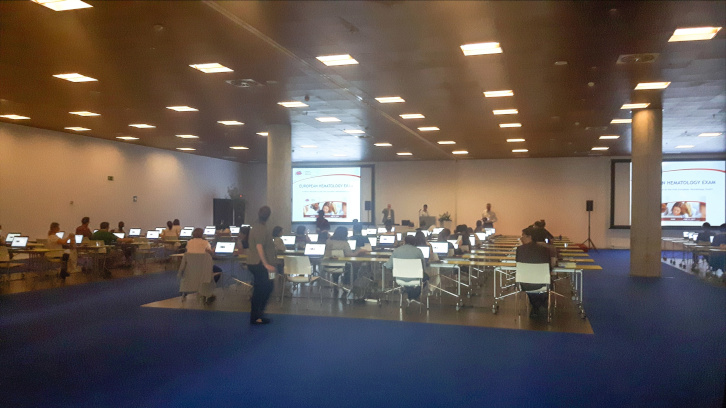The harmonization of Hematology training and its examination in Europe

Harmonizing medical training in the field of Hematology throughout Europe aims to ensure that all European citizens receive the same quality of medical care, regardless of the country they reside in, and to facilitate the mobility of specialists. With this outlined objective, the European Hematology Society (EHA), of which researchers from the UAB and other affiliated centres are members, proposes a unique and high-quality examination model in this area of specialization. Exam questions are designed to allow evaluating the greatest number of skills acquired during the training of professionals, and pose as realistic scenarios as possible. To date, three editions have already been carried out.
The harmonization of the training in Hematology is a primary objective of the European Society of Hematology (EHA) and its committees for education matters (Education Committee and Curriculum Committee). Following the implementation of the European Hematology Curriculum1, the creation of an exam based on it emerged as the next step on the way to harmonize Hematology training throughout Europe. It was not the purpose to substitute the national authorities’ certification role but, instead, to produce a tool to assess knowledge and provide a quality stamp for those who, by passing the exam, reach the standards of knowledge as recommended in the European Curriculum. Moreover, as the exam gains prestige, professional mobility will be facilitated in Europe for those who passed it, as they will have the standards of knowledge recommended by EHA.
Therefore, in 2015 a working group was created to design and develop the European Hematology Exam project2. It was decided that the most appropriate way was to design an exam to test knowledge based on multiple choice questions. This format allows to assess knowledge in several areas in a limited time and it can be used in a web-based format with automatic and objective correction. The questions would be in English as it is the international scientific language and the official language used at EHA. However, in order for the exam to be of high quality, it had to be ensured that the highest number of skills could be assessed through this type of exam. In other words, not only memory capacity was evaluated, but above all other skills such as using theoretical knowledge in daily medical practice. For this purpose, question-writing guidelines were developed by educational and testing experts. The next step was to recruit a panel of experts in all areas of Hematology to produce questions. They were trained in face-to-face workshops on how to write questions that can test the greatest amount of skills. In short, it would be about creating questions by posing scenarios as real as possible with plausible situations even drawn from experiences with patients. The final exams comprised 100 questions, selected from the question data base, representing all (sub)sections of the European Hematology Curriculum. Finally, a panel of 6 experts select and review all the questions of the exam. The exam evaluates all the area of Hematology and Hemotherapy and include both diagnostic and treatment aspects of malignant diseases, such as leukemias and lymphomas, and non-neoplastic diseases, such as anemias or bleeding disorders.
The European Hematology Exam has had three sittings to date, and have taken place during the EHA congress. Currently, there 5 venues where the exam is conducted simultaneously with that of the main venue at the congress. Two hundred and ninety-three candidates have so far participated. These candidates have come from 48 countries representing 5 continents (Table 1).
Table 1. List of participants in the first three European Hematology Exams according to the country of origin.
Like all other activities organized by EHA to harmonize the specialty of Hematology, the final aim of the exam is that all citizens can receive the same medical care when they suffer from a blood disease, regardless of the European country in which they live.
Hematology Department, Institut Català d’Oncologia-Germans Trias i Pujol Hospital.
Josep Carreras Leukaemia Research Institute.
Universitat Autònoma de Barcelona.
References
1Almeida AM, Ar C, Hellström-Lindberg E, Hollegien WWG, Navarro JT, Saris MT, Wondergem MJ, Toh CH. The European Hematology Curriculum: An Electronic Passport Promoting Professional Competence and Mobility. Hemasphere. 2018; 2(3): e49. doi: 10.1097/HS9.0000000000000049
2Navarro JT, Birgegård G, Strivens J, Hollegien WWG, van Hattem N, Saris MT, Wondergem MJ, Toh CH, Almeida AM. The European Hematology Exam: The Next Step toward the Harmonization of Hematology Training in Europe. Hemasphere. 2019 3(5): e291. doi: https://journals.lww.com/hemasphere/Fulltext/

